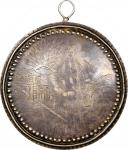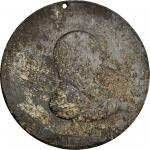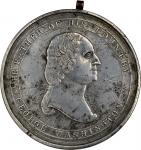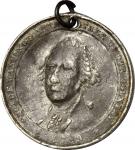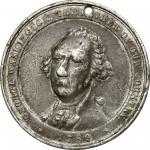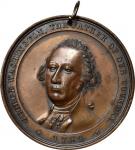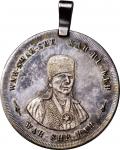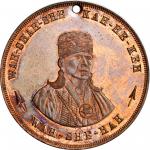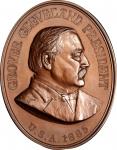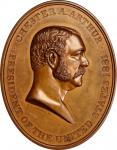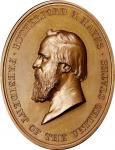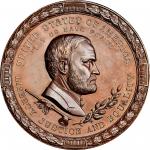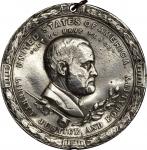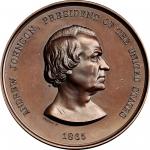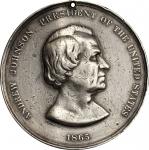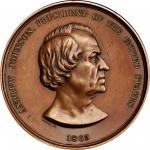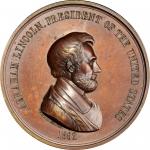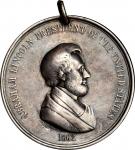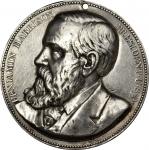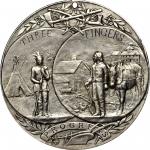1890年本杰明印第安和平奖章 优美
Undated (ca. 1890) Benjamin Harrison Indian Peace Medal. Silver. Julian IP-48, Prucha-58. Choice Very Fine. 76.7 mm. 3463.7 grains. We are thrilled to be able to once again present for sale this incredible medal, with one of the best provenances of any American Peace medal. While the figures involved are not famous, there is a great deal known about one of them, and his is a fascinating story. In addition, we are fortunate that period photographs exist of these people, putting faces to names, so to speak, which is something that very rarely occurs with an awarded Peace medal.This is only the second public offering of this medal. It was first presented in our February 2015 sale, then a new discovery, and one of the writer’s favorite experiences with one of these historic medals. It is presented here with only minor edits to the original 2015 description.Lovely light silver gray with scattered minor scrapes and marks consistent with awarded Peace medals, but free of the more serious marks seen on many pieces. Rather well preserved overall, and very pleasing. Not quite as sharp as the unusually fine specimen we sold in our August 2013 ANA sale, but not far away. This said, it is arguably a much more important medal. Rarely do we have the opportunity to present an Indian Peace medal with a known original recipient, and knowledge of the specific reason it was presented. This is such a case. Just 27 silver Harrison medals were struck, and only a fraction of those are known to survive today. Including this newly discovered example, we are aware of just seven specimens of this historic medal, the final chapter in a long history of officially produced Peace medals struck for presentation to Native Americans.The Benjamin Harrison medals marked a departure from the oval style medals that had been adopted for the Hayes, Garfield, Arthur and Cleveland administrations, this reportedly a reaction to requests from a delegation of four Oto and Missouri men who visited Washington in 1890. They desired and specifically asked for round medals bearing the portrait of the sitting president. According to the account published by Francis Paul Prucha in his Indian Peace Medals in American History</em>, the Oto and Missouri visitors were so adamant about the specific shape and size of the medals that they offered to pay the costs of the medals themselves. This was likely their answer to resistance from the Commissioner of Indian Affairs, who would have realized the bureaucratic difficulty of altering the adopted style of the official medals and probably attempted to dissuade them. Nonetheless, the request was made through proper channels to the Mint, and Mint officials complied. The director of the Mint requested of the Office of Indian Affairs that they propose a new design for the reverse of the medals. A sketch was supplied which was intended to illustrate "progress" in the Native Americans’ adaptations to a way of life, including "a civilized house and occupation," though it was considered only a rough attempt to provide an idea of what would be desirable. A design by Charles Barber was proposed, found agreeable to all concerned, and adopted on May 12, 1890. On October 25, 1890, the first of the round medals, five in number, were forwarded to the Oto and Missouri men who had made the original request. In November 1890, 18 more medals were sent to be distributed to members of the Cheyenne and Arapahoe who had agreed to sell vast lands in Indian Territory to the United States. The list of recipients is known, published in Prucha, and presented here:Little ChiefStarving ElkBob Tail BullGeorge BentCloud ChiefWolf RobeBull ChipLeft HandLittle BearCut NoseLeonard TylerRow of LodgesWhite Eyed AntelopeBlack CoyoteBull ThunderPaul BoyntonScabby BullBuffalo MeatAs noted in Prucha, "some of these medals had the names of the recipients engraved on the reverse." Five of the seven known medals are engraved to the recipients or to names of other members of the Cheyenne and Arapahoe. The present medal fits both categories. It is engraved with prominence, THREE / FINGERS, in letters arcing across the upper portions of the two large circles in the reverse design. Three Fingers, a Cheyenne Chief well documented in the historical photographic record, is not listed among the known original recipients. However, careful study of the medal itself reveals an earlier engraving, largely effaced. In the field below FINGERS can be seen the faint letters of BUFFALO, and just after, very faint remnants of MEAT. It seems, therefore, that this medal was originally Buffalo Meats medal, one of the documented recipients.It is unclear why the name was altered, but the medal obviously became the property of Three Fingers at some point. There are superb photographic portraits of him wearing this medal. The men were contemporaries, and are photographed together in images taken in Washington D.C., in 1895. In one of them, they appear alongside Wolf Robe, another recipient of the Harrison medal who was also well-photographed. Three Fingers is reported to have died in 1917 at the age of 58, and is buried at the City Cemetery at Kingfisher, Oklahoma. Buffalo Meat is a much better documented character. He was born in 1847 or 1849, depending upon the source, and also died near Kingfisher, of tuberculosis, in 1917.The 1895 photograph of Buffalo Meat, Three Fingers and Wolf Robe is interesting in the subtle clues it yields. Buffalo Meat is dressed in Euro-American attire, a black suit, bow tie and broad brimmed black hat. Three Fingers and Wolf Robe are in native Cheyenne attire, and only Wolf Robe wears his Harrison medal. Extensive internet searches yielded more interesting clues as to the stories of these men. Surprisingly, Buffalo Meat is a published artist. According to his entry in The Grove Encyclopedia of American Art, Vol</em>. I, he was accused of participating in the murder of an Anglo immigrant family, and was among six dozen Native Americans imprisoned for the deed at Fort Marion in St. Augustine, Florida. While there, he, along with several other prisoners, is known to have created numerous colorful and distinctive works of art, through the encouragement of the forts commander. The collections of the Massachusetts Historical Society include a book of sketches done by artists in the prison at Fort Marion between 1875 and 1878, and includes works by Buffalo Meat. He was released in 1878, and he promptly returned to Indian Territory.He is reported in the Grove Encyclopedia</em> entry to have later become a policeman, a laborer for the Cheyenne Agency, and eventually a deacon in the Baptist Church. His imprisonment without trial did not likely give him a good impression of the American government, and one could easily imagine that a medal like this one might have meant less to a person in his position. His attire in the 1895 photograph, the social status he eventually attained and his alignment with the Christian church all suggest a departure from traditional ways, and it is easy to imagine that he might have considered personal display of a Peace medal to be part of a tradition he was leaving behind. However, his presence in Washington in 1895 clarifies that he maintained a personal role in supporting the interests of the Cheyenne.Admittedly, these conclusions are conjecture, but they are based on enough evidence to make a case worthy of consideration. The intricate details of this medals history and the relationship between Buffalo Meat and Three Fingers will likely never be known. However, this medal is fascinating to contemplate and the mere opportunity to hold it while looking at the image of Three Fingers wearing it is surreal. It is a bridge between two very different peoples and a tangible artifact of a fascinating, often romanticized period of American history that many would conveniently avoid to contemplate with fairness.In November 2001, we sold the first example of the silver Harrison offered in many years. In fact, as far as we know it had been 65 years since one appeared at auction. There were three appearances at the height of the Great Depression, two in Wayte Raymonds October 1933 sale of the Charles P. Senter Collection, and the reappearance of one of them in Charles H. Fishers sale of March 1936, where it was plated. The incredible holdings of John J. Ford, Jr. revealed three examples, two of which were the Senter medals last sold in 1933 and 1936. The third was from the Wayte Raymond Estate, in 1958. The present medal is the only new one to come to light since the Ford specimens were revealed to modern collectors more than a decade ago. The fact that decades passed between the Fisher sale and the next offering speaks as much to the prized nature of the medals as it does to their great rarity. As there were so few examples of this medal struck to begin with it is not likely that any further pieces will turn up in the near future, if ever. This one is a prize suitable for the finest of collections. Awarded to Buffalo Meat, a Cheyenne Chief, circa November 1890; transferred by unknown means to Three Fingers, another Cheyenne Chief, at an unknown date; unknown intermediaries; Stack’s Bowers Galleries, February 2015, lot 41.




